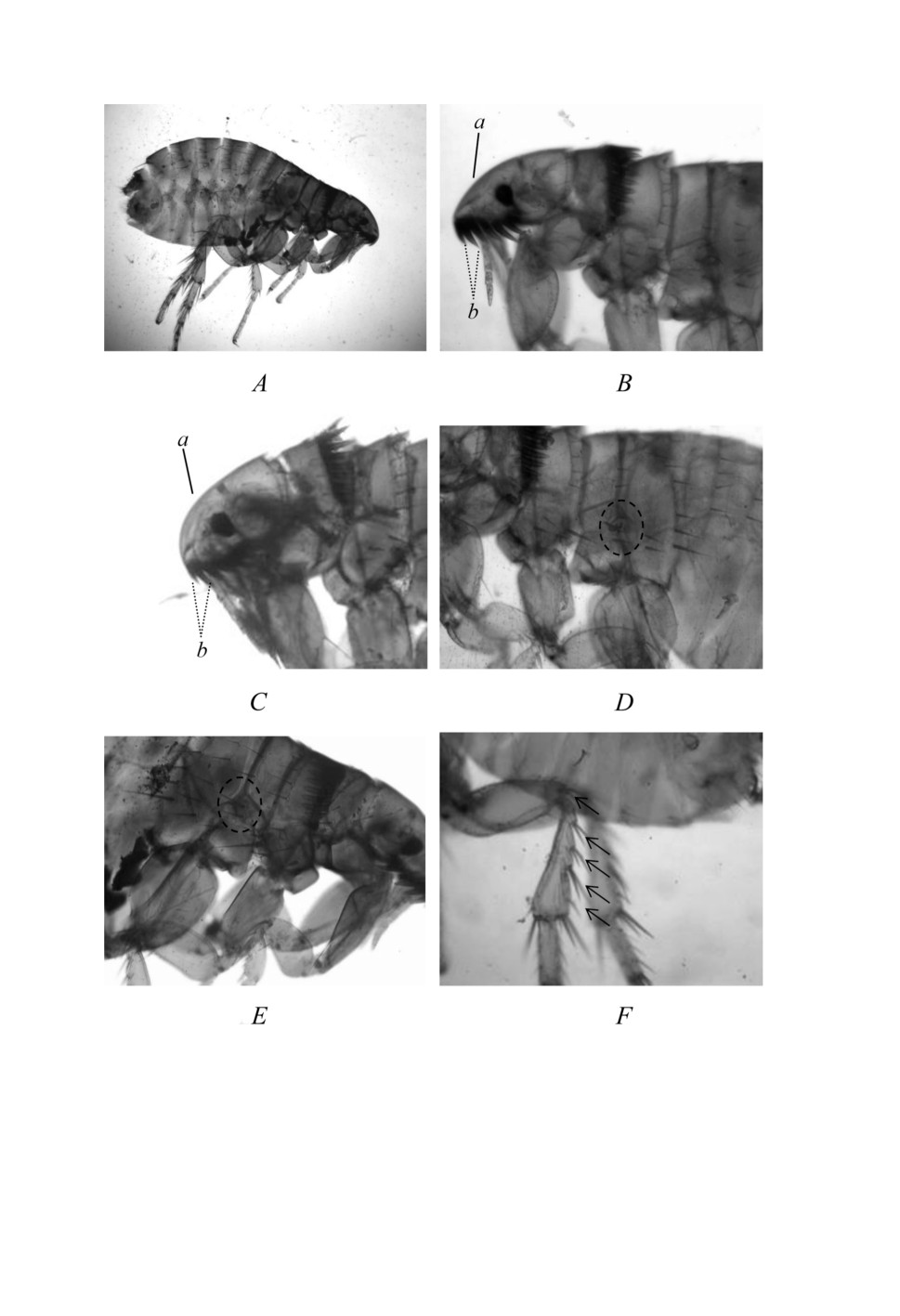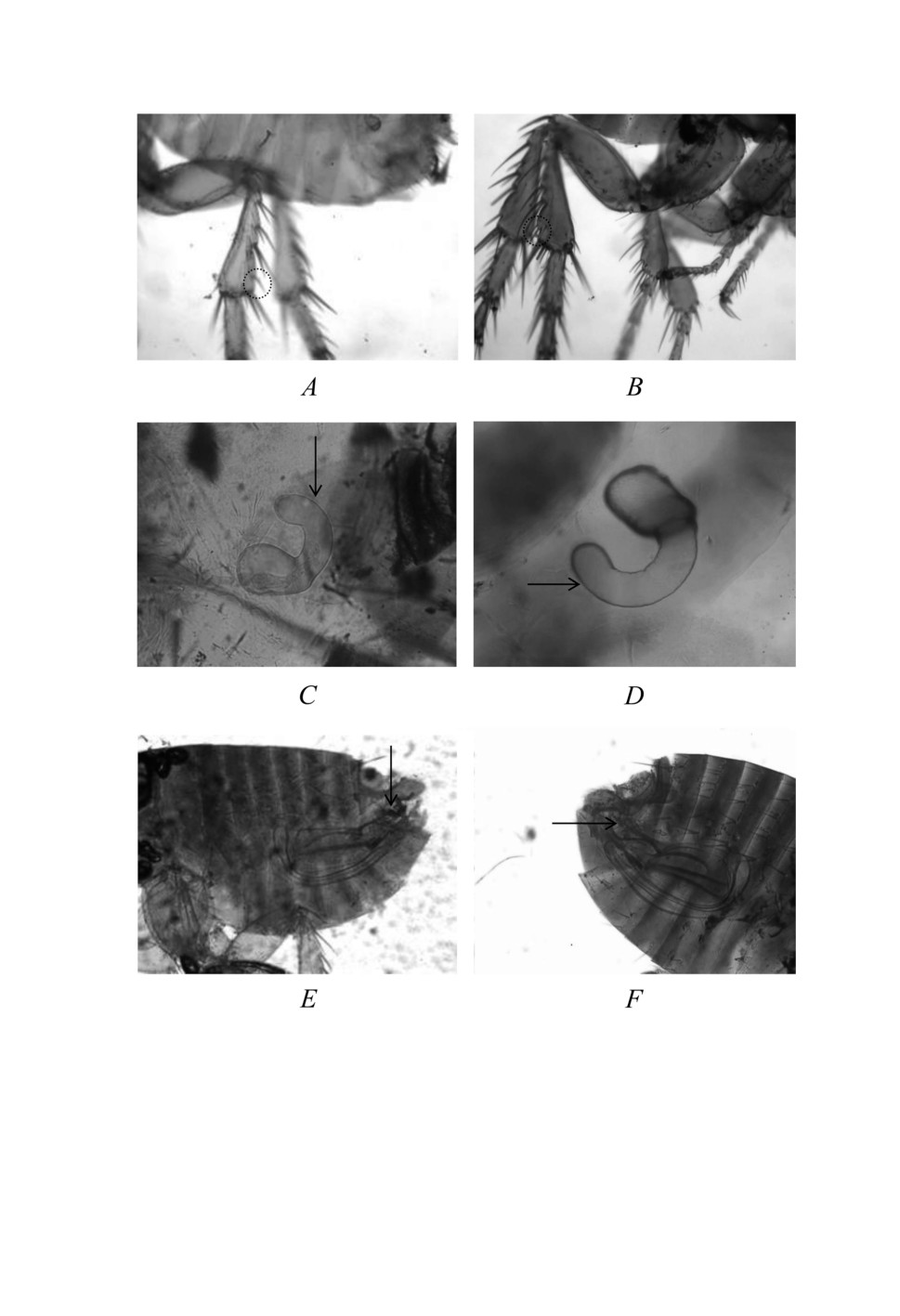ПАРАЗИТОЛОГИЯ, 2020, том 54, № 2, с. 163-172.
УДК 576.591
MORPHOLOGICAL IDENTIFICATION AND PREVALENCE
OF THE DOG FLEA CTENOCEPHALIDES CANIS (CURTIS, 1826)
AND THE CAT FLEA CTENOCEPHALIDES FELIS (BOUCHÉ, 1835)
IN DHAKA CITY, BANGLADESH
© 2020 Yakub Alia, Amrito Barmana, S. M. Abdullaha,
K. B. M. Saiful Islamb, Uday Kumar Mohantaa,*
aDepartment of Microbiology and Parasitology,
bDepartment of Medicine and Public Health,
Sher-e-Bangla Agricultural University,
Sher-e-Bangla Nagar, P. O. Box 1207, Dhaka, Bangladesh
*e-mail: uday_vet01@yahoo.com
Received 12.10.2019
Received after revision 22.12.2019
Accepted 12.01.2020
Ctenocephalides felis (Bouché, 1835) and Ctenocephalides canis (Curtis, 1826) are the most
important flea parasites of dogs and cats throughout the world; they themselves affect the host and act as
vectors of diseases. The main aim of the present study was to assess the prevalence of Ctenocephalides
spp. in both stray and pet dogs and cats in Dhaka City.
A total of 25 flea infested dogs and 25 flea infested cats were collected from 57 dogs and 77 cats,
respectively. A higher prevalence was recorded in stray dogs (61.11 %) and cats (79.17 %) than that in
pet dogs (14.29 %) and cats (11.32 %). The prevalence of flea infestation was 48.28 % in young dogs
and 39.29 % in adult dogs, respectively. In case of cats, 34.62 % young and 31.37 % adults were found
to be infested by fleas. Among the examined dog fleas, 9 (60 %) were C. canis and 6 (40 %) were C.
felis. Again, among the examined fleas of cats, 2 (13.33 %) were C. canis and 13 (86.77 %) were C.
felis. Of the 11 C. canis identified, were 8 (72.73 %) female fleas and 3 (27.27 %) male fleas. Of the 19
examined C. felis identified as 18 (94.74 %) were female fleas and 1 (5.26 %) male flea. Both fleas have
public health significance. Therefore, proper attention needs to be paid for the prevention of flea borne
diseases through the control of dogs and cats.
Keywords: Ctenocehalides canis, Ctenocephalides felis, morphology, prevalence, Dhaka City,
Bangladesh
DOI: 10.31857/S1234567806020066
163
Fleas, particularly species of the genus Ctenocephalides, are common ectoparasites of
dogs and cats throughout the world (Mircean et al., 2010; Gracia et al., 2013; Hajipour et al.,
2015). Fleas are clinically significant parasites for human health since they may play
a role as parasites by themselves causing allergic dermatitis or other conditions due to their
feeding activities. But, which is more important, they also serve as vectors transmitting
important pathogens. The cat flea, Ctenocephalides felis, is a known vector for Bartonella
henselae, Bartonella clarridgeiae, and Rickettsia felis, which can cause cat scratch disease,
endocarditis, and cat flea typhus in humans, respectively (Dryden, Rust, 1994; Kenny
et al., 2003; Kramer, Mencke, 2001). Dog and cat fleas are known to be intermediate hosts of
Dipylidium caninum, which can be transmitted to pets and humans (Soulsby, 1982; Guzman,
1984). Domestic animals such as dogs, cats, or other pets, may play an important role as
bridging hosts for fleas of different wild animals, domestic animals, and humans, as they come
into contact with different animals due to their seeking behavior and therefore acquire the
fleas of different animals (Dobler, Pfeffer, 2011). Fleas are the common etiology of dermatitis,
being responsible for producing allergic dermatitis (Sousa, 2012). Fleas infestations can
cause considerable irritation to animals and humans, and can lead to severe disorders, such
as anaemia and dermatological problems, because repeated infestation of dogs and cats
may result in hypersensitivity to components of flea saliva, which, in its turn, can cause
flea allergic dermatitis (Dryden, Rust, 1994; Kunkle et al., 2003; Newbury, Moriello, 2006).
These cat and dog fleas are known as vector of pathogens causing plague, murine typhus, and
feline leukemia. Approximately 94 % of all flea species are reported to feed on mammals.
The dog flea, C. canis, is an important ectoparasite of both wild and domestic canids around
the world (Durden et al., 2005). It is similar in appearance to the ubiquitous cat flea, C. felis,
but is encountered less frequently and thus has not been studied thoroughly. At least
36 important zoonotic diseases are acquired from dogs worldwide, although the occurrence
of some important zoonotic diseases acquired from dogs have reported from Bangladesh but
the inland reports on this aspect are very limited.
In our country, no detailed research on the mentioned flea species was performed. In the
present work, we had examined fleas collected from dogs and cats in Dhaka city.
MATERIALS AND METHODS
Site selection
Fleas were collected from several areas in Dhaka city, including as the Central Veterinary Hospital
(CVH) at Alauddin road, People for Animal Welfare (PAW) at Lalmatia, Care for Paws (CFP) at Bosila
and Sher-e-Bangla Agricultural University (SAU), Bangladesh. Both stray and pet dogs and cats were
considered as study animal for the collection of fleas.
164
Restraining of animals
Pet dogs and cats were restrained with the help of the owners. On the other hand, stray dogs and
cats, were restrained with the help of the assistant by covering the mouth with mask. Some dogs and
cats, which were anaesthetized during neutering or spaying, were examined for the presence of fleas.
Sample collection and preservation
Dogs and cats of all age groups and sexes in Dhaka City were considered as study animals. Dogs
and cats were exhaustively examined for fleas through an inspection of the head, neck, body, sides,
tail, and ventral regions of each animal. Fleas were collected by the use of forceps, and hand picking.
Collected fleas were stored in collection vials with proper labeling, and using a record book for further
information. Captured fleas were transported to laboratory of Microbiology and Parasitology, Sher-e-
Bangla Agricultural University, Bangladesh. Collected fleas were preserved in 70% ethanol for their
preservation and identification based on morphological features to the species level.
Clearing: Fleas were cleared by dissolving in 10 % potassium hydroxide (KOH) solution at room
temperature for overnight to allow transmitted light to pass through them. After clearing with KOH,
specimens were returned to distilled water or alcohol before being passed through the alcohol series
for dehydration.
Staining: Hematoxylin dye was used to stain the specimens. Specimens were kept in Hematoxylin
for overnight. Hematoxylin was added to the specimens while they were in 70 % alcohol. The specimen
became darker and darker as time in the stain was increased. Some of the stain leached from the
specimen in later stages of the dehydration series, so over staining was done to produce proper darkness
of the specimen.
Dehydration and mounting: Water was removed by dehydration because water in the specimen
would cloud the slide and make it difficult to see the desired characteristics as well as to prevent
specimen from spoiling by bacteria. Dehydration was accomplished by passing the specimens through
a series of increasingly concentrated grades of ethanol for 30 minutes in each step.
After dehydration in 100 % ethanol, the specimen was soaked in xylene before mounting on slides.
The amount of time spent in each step depends on the thickness of the specimen. The dehydrated
specimen was observed under microscope just before mounting in Canada balsam medium to observe
whether it is cleaned. If clouding was visible, the specimen was returned to earlier stages in the
dehydration series. After mounting, slides were dried very slowly by allowing them for several days.
The specimens were handled with care during the mounting process. Fine forceps, needles and insect
pins were used to handle the specimens during the mounting process.
Microscopic examination for morphology study
All fleas were identified microscopically at the laboratory, according to the keys and description for
identification (Lewis, 1993; Menier, Beaucournu, 1998; Durden, Traub, 2002).
RESULTS
A total of 15 fleas from 5 infested dogs, and 15 fleas from 6 infested cats were objected to
morphological identification. Two species, C. canis and C. felis were identified. Morphological
differences between the revealed species are shown in Figs. 1 and 2, and in Table 1.
165
A total of 57 dogs and 77 cats were examined for infestation by fleas belonging to the
genus Ctenocephalides from different veterinary clinics and animal welfare associations of
Dhaka City (Table 2). A total of 25 flea infested dogs and 25 flea infested cats were found
from 57 dogs and 77 cats examined, respectively. In this study, a higher infestation rate of flea
was recorded in dogs (43.86 %) than in cats (32.47 %) (Table 2).
Higher infestation rate of flea was recorded in dogs (50%) rather than cats (24 %) in the
Central Veterinary Hospital (CVH). The prevalence of flea was observed in dogs (42.86 %)
and cats (34.09 %) in the veterinary clinics of People for Animal Welfare (PAW) at Lalmatia
(Table 3).
DISCUSSION
In the present study, two species of the genus Ctenocephalides were found in both dogs
and cats.
The population of C. canis was observed on dogs and cats from all the geographical
localities of Dhaka City. The individuals presented typical characteristics of this species: head
strongly convex anteriorly in both sexes and not noticeably elongate; the length of the head
was not twice longer than wide. Genal ctenidium presenting the first spine was approximately
shorter than the second one. Three spines were observed in the metepisternite or LMA in all
the individuals. Hind tibia with seven to eight seta-bearing notches along the dorsal margin
and presence of two single, short and stout bristles located between the postmedial and apical
long bristles were found in hind tibia. The manubrium of the clasper was dilated towards
its apex in case of male individuals. Typical spermatheca with apical part of elongated
hilla was observed in the posterior end of females. These above mentioned morphological
characteristics were agreed with those cited by Lewis (1993), Menier, Beaucournu (1998),
Beaucournu, Launay (1990), and Durden, Traub (2002). However, the degree of dilation of
the apex and the degree of elongation of the apical part (hilla) of the spermatheca was the
most differential character between both species what was in agreement with Menier and
Beaucournu (1998) and Lewis (1993), respectively. The length observed between the first
and the second genal spines was the most specific biometrical parameter observed between
both species and it was in agreement to Durden and Traub (2002), the length and wide ratio
of the head was a specific parameter to differentiate C. felis and C. canis.
In this study, an overall high prevalence of fleas was recorded in both dogs (43.86 %)
and cats (32.47 %) in Dhaka City. This high prevalence suggests that these fleas are very
common, and present major problems with regard to the health, and performances of these
important animals in the study area. Higher prevalence of fleas was observed in dogs than
that in cats, which may be due to more efficient grooming behavior of cats (Eckstein, Hart,
2000). Higher prevalence of fleas in stray dogs and cats than pet dogs and cats in Dhaka
166
Table 1. Differential morphological properties between C. felis and C. canis
Characteristics
C. felis
C. canis
Shape of the head
Length is generally greater than
Length is not twice of the height
twice of the height of head
of head (Fig. 1Ca)
(Fig. 1Ba)
Length of the 1st and 2nd
First two spines are approximately
First spine is half as long as
spine of genal comb
equal in length
second spine in length (Fig. 1Cb)
(Fig. 1B a)
Number of bristles on the
Two (Fig. 1D)
Three (Fig. 1E)
LMA or metepisternite
Number of notches on
Tibiae of all 6 legs have
Tibiae of all 6 legs have
tibiae
5 to 6 notches (Fig. 1F)
7 to 8 notches
Number of stout bristles
One stout bristle in the interval
Two stout bristles in the interval
on the dorsal margin of the
between post-median and apical
between post-median and apical
hind tibia
long bristles (Fig. 2A)
long bristles (Fig. 2B)
Metatibial formula of
2-2-2-2-1-3
2-2-2-2-2-1-1-3
chaetotaxy
Male: shape of the
The clasper of the manubrium
The clasper of the manubrium
manubrium of the clasper
is not expanded apically (Fig. 2C)
is expanded apically (Fig. 2D)
Female: length of hilla
Spermatheca contains short hilla
Spermatheca contains
of spermethica
(Fig. 2E)
comparatively long hilla (Fig. 2F)
Table 2. Overall number of animals was examined for flea infestation
Animal
Animal infested, %
Dog (n=57)
25 (43.86)
Cat (n=77)
25 (32.47)
Total (134)
50 (37.31)
Table 3. Comparison of the overall number of examined animals according to collection site
Location
Animal
Animal infested, %
Central Veterinary Hospital (CVH)
Dog (n=18)
9 (50)
Cat (n=25)
6 (24)
People for Animal Welfare (PAW)
Dog (n=35)
15 (42.86)
Cat (n=44)
15 (34.09)
Sher-e-Bangla Agricultural University (SAU)
Dog (n=1)
-
Cat (n=6)
3 (50)
Care for Paws (CFP)
Dog (n=4)
2 (50)
Cat (n=1)
-
Total
(134)
50 (37.31)
167
Figure 1. A - morphology of the genus Ctenocephalides (female); B - female of C. felis (10X).
a - shape of the head (black line), b - Length of the 1st and 2nd spines of genal comb (broken lines);
C - female of C. canis (10X), a - shape of the head (black line), b - length of the 1st and 2nd spines
of genal comb (broken lines); D -female of C. felis (10X). Number of bristles on the lateral metanotal
area (LMA) or metepisternite (broken circle); E -female of C. canis (10X). Number of bristles on the
lateral metanotal area (LMA) or metepisternite (broken circle); F -Female of C. felis (10X). Number
of notches (5) on the hind tibia (black arrow).
168
Figure 2. A - Female of C. felis (10X). Number of stout bristles between post-median and apical long
bristles of the hind tibia (broken circle); B - female of C. canis (10X). Number of stout bristles between
post-median and apical long bristles of the hind tibia (broken circle); C - female of C. felis. Length
of hilla of spermathica (black arrow); D - female of C. canis. Length of hilla of spermathica (black
arrow); E - male of C. felis (10X). Shape of the manubrium of the clasper (black arrow); F -male of
C. canis (10X). Shape of the manubrium of the clasper (black arrow)
169
City, which confirms to the previous study (Hsu, Wu, 2001 ) where it was reported that
80 of stray cats and 60 of stray dogs were infested with C. felis in Taipei, Taiwan. Lower
prevalence of fleas was recorded in pet dogs and cats may be due to proper supportive care
and management by their owners.
The prevalence amongst animals, more female fleas was recorded on animals in this
study. The most probable reason for this is that female individuals usually have a longer
lifespan than the male individuals. Male individuals also spend more time off the host and are
therefore more prone to predation or starvation than female individuals (Durden et al., 2005).
CONCLUSIONS
Fleas are clinically important ectoparasites for animal and human health since they
may play a role as parasites by themselves causing allergic dermatitis or other conditions.
Sometimes they serve as vectors and transmitting important disease causing pathogens. The
information presented here improves our understanding of flea infestation in Bangladesh.
In order to avoid any unpleasant situations, adequate preparations of flea control should be
implemented in Dhaka city and other parts of Bangladesh.
ACKNOWLEDGEMENT
This project was supported by Ministry of National Science and Technology, Bangladesh.
CONFLICT OF INTERESTS
The authors declare that there is no conflict of interest about this publication.
REFERENCES
Dobler G., Pfeffer M. 2011. Fleas as parasites of the family Canidae. Parasite and vector 4: 139.
Dryden M.W., Rust M.K. 1994. The cat flea: biology, ecology and control. Veterinary Parasitology 52: 1-19.
Durden L.A., Judy T.N., Martin J.E., Spedding L.S. 2005. Fleas parasitizing domestic dogs in Georgia, USA: species
composition and seasonal abundance. Veterinary Parasitology 130: 157-162.
Durden L.A., Traub R. 2002. Medical and Veterinary Entomology, vol. 7. Academic, San Diego, 103-125 pp.
Eckstein R.A., Hart B.L. 2000. Grooming and control of fleas in cats. Applied Animal Behaviour Science 68:
141-150.
Gracia M.J., Calvete C., Estrada R., Castillo J.A., Peribanez M.A., Lucientes J. 2013. Survey of flea infestation in
cats in Spain. Medical and Veterinary Entomology 27: 175-80.
Guzman R. F. 1984. A survey of cats and dogs for fleas: with particular reference to their role as intermediate hosts
of Dipylidium caninum. New Zealand Medical Journa. 32: 71-3.
Hajipour N., Tavassoli M., Gorgani-Firouzjaee T., Naem S., Pourreza B., Bahramnejad K., Arjmand J. 2015.
Hedgehogs (Erinaceus europaeus) as a Source of Ectoparasites in Urban-suburban Areas of Northwest of
Iran. Journal of Arthropod-Borne Diseases 9: 98- 103.
170
Hsu M. H., Wu W. J. 2001. Off-host observations of mating and postmating behaviors in the cat flea (Siphonaptera:
Kenny M.J., Birtles R.J., Day M.J., Shaw S.E. 2003. Rickettsia felis in the United Kingdom. Emerging Infectious
Disease Journa 9: 1023-1024.
Krämer F., Mencke N. 2001. Flea biology and control: the biology of the cat flea control and prevention with
imidacloprid in small animals. Springer Berlin Heidelberg, 318 pp.
Kunkle G.A., McCall C.A., Stedman K.E., Pilny A., Nicklin C., Logas D.B. 2003. Pilot study to assess the effects
of early flea exposure on the development of flea hypersensitivity in cats. Journal of Feline Medicine and
Surgery 5: 287-294.
Lewis R.E. 1993. Notes on the geographical distribution and host preferences in the order Siphonaptera. Part 8. New
taxa described between 1984 and 1990, with a current classification of the order. Annals of Entomological
Society of America 30: 239-256.
Menier K., Beaucournu J.C. 1998. Taxonomic study of the genus Ctenocephalides Stiles & Collins, 1930 (Insecta:
Siphonaptera: Pulicidae) by using aedeagus characters. Medical and Veterinary Entomology 35: 883-890.
Mircean V., Titilincu A., Vasile C. 2010. Prevalence of endoparasites in household cat (Felis catus) populations from
Transylvania (Romania) and association with risk factors. Veterinary Parasitology 171: 163-166.
Newbury S., Moriello K.A. 2006. Skin diseases of animals in shelters: triage strategy and treatment recommendations
for common diseases. Veterinary Clinics of North America: Small Animal Practice 36: 59-88.
Sousa A.C., 2012. Flea allergy and control. In: Jackson H., Marsella R. (Eds), BSAVA Manual of Canine and Feline
Dermatology, 3rd edition. BSAVA Woodrow House, Gloucester, 146-152.
Soulsby E.J.L. 1982. Helminths, Arthropods and Protozoans of Domesticated Animals. 7th edn., London, Baillienmire
Jindan.
МОРФОЛОГИЧЕСКАЯ ИДЕНТИФИКАЦИЯ И РАСПРОСТРАНЕННОСТЬ
СОБАЧЬЕЙ БЛОХИ CTENOCEPHALIDES CANIS (CURTIS, 1826)
И КОШАЧЬЕЙ БЛОХИ CTENOCEPHALIDES FELIS (BOUCHÉ, 1835)
В ДАККЕ, БАНГЛАДЕШ
© Якуб Алиa, Амрито Барманa, С. М. Абдуллахa, К. Б. М. Сайфул Исламb,
Удай Кумар Мохантаa,*
a Отдел микробиологии и паразитологии,
b Отдел медицины и здравоохранения,
Сельскохозяйственный Университет Шер-е-Бангла,
Шер-е-Бангла Нагар, п/я 1207, Дакка, Бангладеш
*e-mail: uday_vet01@yahoo.com
Ключевые слова: Ctenocehalides canis, Ctenocephalides felis, морфология, распро-
странение, Дакка, Бангладеш
171
РЕЗЮМЕ
Блохи Ctenocephalides felis (Bouché, 1835) и Ctenocephalides canis (Curtis, 1826) являются
наиболее важными паразитами собак и кошек по всему миру; сами блохи вредят хозяевам и,
кроме того, служат переносчиками заболеваний. В цели данной работы входила оценка распро-
странения блох у домашних и бродячих собак и кошек в городе Дакка.
Из 57 исследованных собак и 77 кошек, 25 собак и 25 кошек были инфицированы блохами.
Блохи чаще встречались на диких собаках (61.11 %) и кошках (79.17 %), по сравнению с до-
машними собаками (14.29 %) и кошками (11.32 %). Зараженность молодых собак была выше
(48.28 % ) в сравнении со взрослыми собаками (39.29 %). Среди кошек,
34.62 % молодых
и 31.37 % взрослых кошек были заражены блохами. Среди блох, собранных с собак, 9 (60 %)
были представлены C. canis и 6 (40 %), C. felis. В то же время, среди блох, собранных с кошек,
2 (13.33 %) были представлены C. canis и 13 (86.77 %) C. felis. Из 11 определенных блох C. canis,
обнаружилось 8 (72.73 %) самок и 3 (27.27 %) самца. Из 19 изученных кошачьих блох C. felis,
18 (94.74 %) были представлены самками и 1 (5.26 %) самцом. Оба вида блох важны с точки зре-
ния здравоохранения, поэтому следует уделить особое внимание предотвращению распростра-
нения болезней, передаваемых блохами, путем ограничения численности бродячих животных.
172









